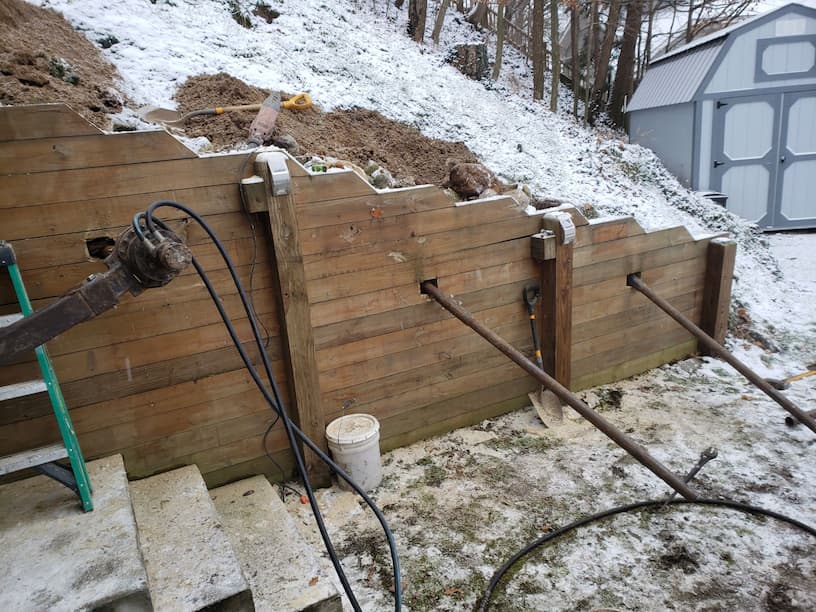
Originally posted 2/18/21, updated 12/15/22
If you’ve heard of helical tiebacks before, you’ve probably been researching repair methods for bowing or leaning walls. A wall begins to move when the pressure from the soil around the foundation becomes over-saturated with water. Left untreated, these weakened walls will eventually collapse, causing massive structural damage to your house.
Acculevel is a foundation repair company that has been stabilizing and repairing bowed walls since their start in 1996. We’ve installed carbon fiber straps, wall anchors, or helical tiebacks for thousands of customers, restoring health and stability to homes throughout our service area. We strongly believe that part of our service is educating homeowners, so they can successfully determine the best course of action for themselves and their homes.
In this article, we’re going to address several questions we often encounter about helical tiebacks. We’ll explain how they differ from wall anchors, when they should be used, and how they can also be used to shore up foundations in some unusual situations.
Let’s start at the beginning, shall we? A wall anchor is a method for reinforcing a bowing wall. It’s normally used when a wall is bowing more than 2 inches, which is when carbon fiber straps are no longer advisable.
Wall anchors include three major components: the bracket that attaches to the wall from the inside of the basement, the anchor that is buried in the yard, and the steel rod that connects them. They are less expensive than tiebacks, but they require excavation. The anchor needs to be buried in the yard approximately 10 feet away from the bowing wall.
If you have any obstructions in that 10 foot range, the excavation could be ill-advised or even completely out of the question. For example, that may be where your propane tank is set- you probably don’t want to move it. Or if excavation will go through an in-ground pool, you definitely don’t want to move that. And if it’s in your neighbor’s yard? You can’t excavate someone else’s property. (Okay, maybe you can if they’re not home, but it’s likely to land you in court later.)
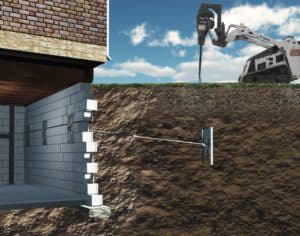 This is an illustration of how wall anchors are installed. You can see how installing the anchor could be problematic for some homeowners.
This is an illustration of how wall anchors are installed. You can see how installing the anchor could be problematic for some homeowners.
Helical tiebacks only have two components: the plate or channel attached to the basement wall, and the screw-like shaft that is driven into the earth outside the home. They do not require excavation, because they are installed entirely from inside the home. The bracket is attached to the wall, and the tieback is drilled through the wall, at a downward angle into the soil.
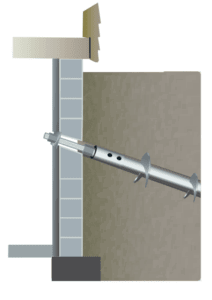 This is an illustration of how helical tiebacks are installed. All of the work is done from inside the basement, and the tieback is drilled at a downward angle to avoid obstructions on the property.
This is an illustration of how helical tiebacks are installed. All of the work is done from inside the basement, and the tieback is drilled at a downward angle to avoid obstructions on the property.
Helical tiebacks are the most expensive option for stabilizing a bowing wall. They cost approximately $1812-1952 per tieback, depending on if they can be installed by machine or by hand.
Sometimes, a homeowner has a retaining wall that is starting to fail. These can be shored up (reinforced) by some of the same methods we use for foundation repairs. But again- excavation can be a major problem. In the pictures below, we demonstrate how tiebacks were used to repair a retaining wall for a customer in Southern Michigan.
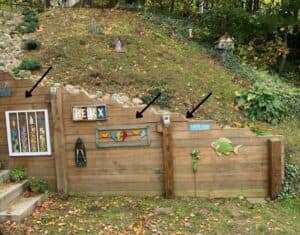 BEFORE: This picture was taken by an Acculevel project advisor. The arrows highlight where gaps are developing in the wall. You can see how difficult excavation would be at this location.
BEFORE: This picture was taken by an Acculevel project advisor. The arrows highlight where gaps are developing in the wall. You can see how difficult excavation would be at this location.
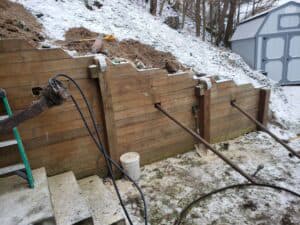 DURING: This picture was taken by the Acculevel crew, during the installation. A hole was cut in the wall, so the tieback can be drilled through it, deep into the earth behind the wall. Once the needed tension is met (measured by a pressure gauge), the tieback will be securely fixed to the wall.
DURING: This picture was taken by the Acculevel crew, during the installation. A hole was cut in the wall, so the tieback can be drilled through it, deep into the earth behind the wall. Once the needed tension is met (measured by a pressure gauge), the tieback will be securely fixed to the wall.
 AFTER: This is the retaining wall, after repairs were completed. (This picture was also provided by the Acculevel team.)
AFTER: This is the retaining wall, after repairs were completed. (This picture was also provided by the Acculevel team.)
We have developed a detailed foundation guide that addresses our customers’ most often asked questions. It starts with the causes of foundation damage, reviews the symptoms to watch for, issues from cracks to settling, repair methods and costs.
If so, you’ll want to find a skilled and reputable contractor in your area. You can ask friends or neighbors who they would recommend, if they’ve had similar problems. The realtor who sold you the house is also a great resource; many agencies have a list of contractors that they regularly use during the sales process.
We highly recommend that you verify the contractor through the Better Business Bureau, also. If you live in our coverage area, don’t hesitate to contact us for a free estimate. We will schedule an appointment for you with one of our knowledgeable and experienced project advisors, who will evaluate your house and provide you with the best whole home solutions available.
If you have not hired a repair company before, or if you didn’t have a great experience last time, please read our checklist of questions to ask a contractor. This guide is the result of multiple meetings with staff, crews, and project advisors; its purpose is to help you know which questions to ask, what kinds of answers to be wary of, and how to determine if you do (or more importantly, don’t!) want to do business with a specific company. We don’t want you to be cheated by an unethical company, or taken advantage of by a scam artist pretending to be a legitimate contractor.
[DISPLAY_ULTIMATE_SOCIAL_ICONS]